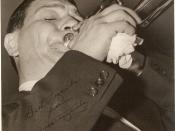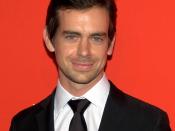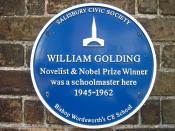Through out the book, William Golding uses description of the physical world to illustrate the different personalities of the main characters of the book; different light and sound effects are used for this purpose. Also, Golding descriptions of the natural world found in the island are used to hint the fact that there is also evil hidden in the overall beauty of the landscape. I believe that more than just trying to give us an impression that the island was already "dark" and "evil", he is trying to show that there is a balance of forces between this and the "light" we also find. I guess that his purpose is to show that different kinds of people tend to move the balance towards one of this "forces", allowing one of the two to take over or, if there are two people trying to move the balance in different directions, for chaos and conflict to develop.
Since the beginning of the book, Golding shows us how nature has got both a beautiful and an evil side: "palm trees"æ stood or leaned or reclined against the light and their green feathers were a hundred feet up in the air. The ground beneath them was"æ covered with coarse grass, torn everywhere by"æ the fallen trees, scattered with decaying coco-nuts" Life and beauty, represented by the "light" and the almost mythical image of the "green feathers" that covered the palm trees, show us the exuberant images that the island was covered on. At the same time, the same picture contains words and images that reminds us of death and of the evil that is also contained in nature; the "decaying coco-nuts" is an example. This is just one of then numerous times that Golding uses this to illustrate the two sides of things. Also in chapter one we have got "the skull like coco-nuts" and ,in chapter two, when the "litluns" are feeling the "late smart of the sunburn" showing us how the enjoyable sun can also be dangerous, and many others. Is a way of reminding us that the world (because that us what the island is, I think, a mini representation of the world) has got its good side and its dangerous side, both which are inherent and natural, both needed to make us conscious of the presence of the other.
In addition, we have got how the characters react towards the world, what helps us to understand more of their personalities. At the end of chapter one there is a very representative paragraph that more or less summarises how the attitudes of three of the main characters (Simon, Ralph and Jack) will be. It is to do of how they react towards some "green buds" they find at the top of the mountain: Simon's reaction is the most sensitive one "Like candles. Candle bushes. Candle buds." he says. "You couldn't light them" said Ralph. "They just look like candles" Jack, seeing no use of the flowers "slashed at one his knife" and "contemptuously" said: "Green candles, we can't eat them. Come on". From this series of reactions we can see that Simon is the most sensitive one, the one that tries to see beyond the obvious, who appreciates the natural world in which he is and lives in harmony with it. Then we have Ralph; he is definitely the rational one, that wants to stick to what he sees (so as to preserve order maybe? I mean, when you all see things the same way, you cannot argue about them). Finally, we have got Jack: he wants to exploit nature to his advantage. Anything that is of no use for him he merely ignores or destroys, and this attitude it is not limited to plants only, as the attitudes of the others is also a representation of their attitude towards life itself.
Golding also uses descriptions of nature itself when some characters are around to describe the way those characters look at nature, if not how they are naturally. At the beginning of chapter three there is a description of how Jack is chasing a pig in the middle of the forest. The description of how he acts is alone revealing, but the way nature behaves around him is so too. The surrounding is described as "semi-dark", the forest was "very still" and "silent", the birds did not sing but produced a "harsh cry". No colour was found, the trees "grew pale flowers", no life. Is it almost as if time had stopped because of Jack's presence. I believe that this is an example of the balance of forces leaning towards evil when Jack, a powerful boy between the others, that is always associated with evil and "darkness", has nothing good strong enough to oppose him and give an equilibrium that would enable things to present both of their facets. On the other hand we have how nature behaves around Ralph, who represents goodness and civilisation. In chapter one the shadows on his body were "green", not black or dark, almost insinuating that darkness cannot touch him. He is usually described in the presence of light, and even his hair is fair coloured. There is nothing evil around him, and that makes him a bit naÃÂïve. He does not see the danger in the island at all, and, because of this, sees their situation as a kind of adventure. I think that maybe the excess of "light" blinds him and does not allow him to see the complete picture, like the sun can blind when it shines too much. I believe that this is a symbol that represents all of those people that, because they have lived in the innocent ignorance of evil, they cannot see it when it is right in front of them, as the people queuing to enter the army so as to fight in the First World War could not see the danger that was awaiting them.
In addition, we have nature's behaviour when Simon is around. Specially at the end of chapter three, we can see that he can appreciate both sides of nature, and feel comfortable with both. His retirement spot, where he feels "safe" is just between two very different kinds of landscape: one of them has got trees that where "flower and fruit grew together"æand everywhere was the scent of ripeness and the booming of a million bees", the bees "roar", there is "sunlight". Life, sound and colour all mix up in one spot, like in Ralph's forest, showing all the goodness of the natural world. In the other landscape "trees bore unexpected pale flowers" and "the air was dark" (Jack's forest is similar to this one). This was not place for Simon either, because he needs both sides of things to be present, so as to level things and keep them real. He chose his place to be "walled with dark aromatic bushes, and was a bowl of heat and light". A fallen tree leaned against those that were still standing and that had "red and yellow sprays" on their tops. Where he decided to stay, light and darkness are together, sounds and silence are both present at intervals and some things are colourful while some are not. This shows us that he is not ready to dismiss any of the sides because both form part of his personality. That is why he can be a bridge between Jack (Simon is a choir boy) and Ralph, without being unconditional to none of them. I think that that is why he is seen as an outsider, because he is unable to, as everyone else does, to side with one of the older boys, therefore he is thought to be strange by both sides.
To conclude, I believe that Golding makes the physical world relevant by connecting it to the personalities and feelings of each character. That way the descriptions of different light intensities and sounds will immediately hint the mood of the situation to the reader after having related them to one of the characters that represent either evil, goodness, or a balance between both. I also believe that Piggy does not seem to be related to any of this because, even though he is on e of the main characters, he tends to support the person that seems to be nice and open with him. If Jack had been that person, Piggy would have probably accepted Jack's authority with no further complain instead of becoming Ralph's unconditional partner.





